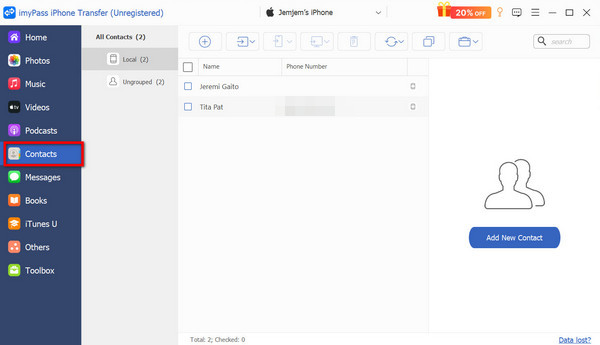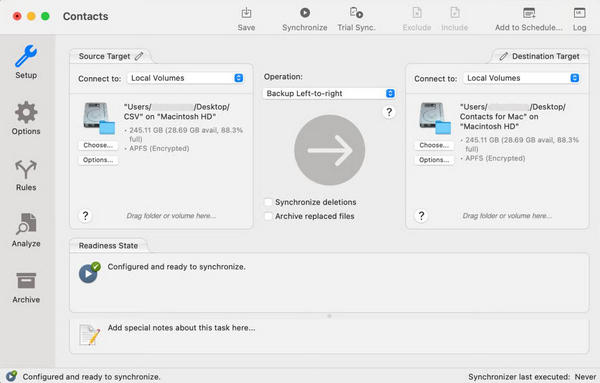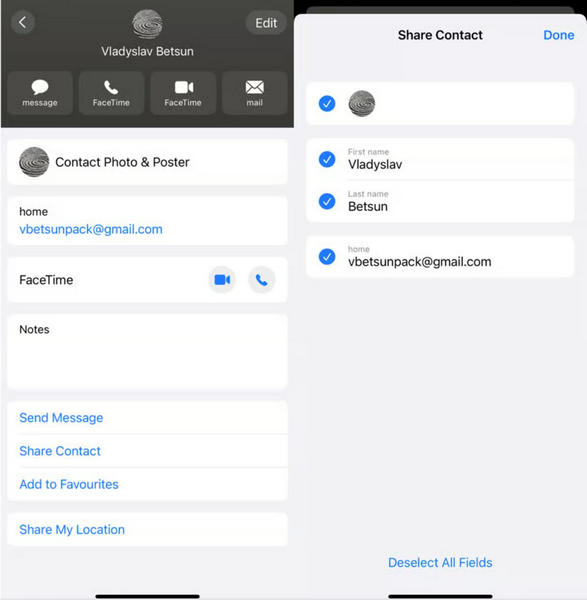Best Ways to Sync Contacts Between iPhone and Mac Quickly and Safely
Imagine working on your Mac and suddenly needing a phone number that is stored only on your iPhone. Situations like this can be frustrating and disruptive. That is why it is essential to know how to sync contacts from iPhone to Mac, so you will always have your address book readily available. With the correct method, whether iCloud, Finder, AirDrop, or third-party tools, you can seamlessly update and access all your contacts across devices, ensuring you stay connected anytime, anywhere.

In this article:
Method 1: imyPass iPhone Transfer (Most Recommended)
Smartly organizing and managing your contacts across your iPhone and Mac can be done with imyPass iPhone Transfer. This tool provides a seamless way to sync, transfer, and organize your iOS data, eliminating the need for iTunes or iCloud. With imyPass, you can move contacts cleanly and efficiently, maintaining organization and preserving properties across iPhones and Macs. The precision, speed, and flexibility features of imyPass iPhone Transfer are what most users praise, making it the most recommended method for contact synchronization.

4,000,000+ Downloads
Transfer all or selected contacts instantly from iPhone to Mac.
Create, edit, or delete contacts directly on Mac.
Automatically detects and removes duplicate contacts.
Save contacts on your Mac for backup and restore them at any time.
Works with iPhones, iPads, and iPods, ensuring full iOS compatibility.
Download and Install the Tool
To get started, visit the official site and download the imyPass iPhone Transfer application for your Mac. Installation of the program is simple; follow the setup instructions.
Connect the iPhone to the Mac
Establish the connection using the USB cable, and also launch the iPhone Transfer tool. The program will automatically recognize your iPhone.

Select the Contacts Tab
Click on Contacts on the left. The program will take a moment to retrieve all the iPhone contacts and will display them with all the details, including numbers.

Manage and Organise Contacts
Before syncing, you may delete unwanted contacts, edit your contacts, and even create new ones. This also includes merging duplicates to keep your contacts list orderly.
Sync Contacts to Mac
To perform the transfer instantly, press the Export to Device button, which also backs up your contacts in a simple CSV or vCard format for easy access.

Restore or Import Contacts (Optional)
To facilitate contact transfer back to your iPhone or any other device, you can eliminate the hassle by using the single Import button.
Method 2: iCloud Sync
Most, if not all, iPhone users have iCloud on their Apple devices. This accounts for the simplest and most reliable method for syncing contacts with your iPhone and Mac. After making the initial setup, contact alterations on your Mac or iPhone, such as adding or editing, will be automatically updated across both devices, providing you with a seamless and stress-free experience.

On your iPhone, open Settings > [your name] > iCloud.
Toggle Contacts on.
When prompted, tap Merge to combine existing contacts with iCloud.
On your Mac, click the Apple menu > System Settings.
Select your Apple ID/iCloud account, then click Show More Apps.
Toggle on Contacts.
Method 3: Finder
If you prefer to have a local copy of your contacts instead of using iCloud, you can also do so manually and store your contacts offline. Here is how:

Use a decent USB cable to connect your iPhone to your Mac. This establishes a solid connection between your iPhone and Mac, enabling seamless data transfer.
Open Finder from the Dock or open a new Finder window to access Finder.
In the left sidebar of Finder, you should see your iPhone name under the Locations. Click it once.
Click the Info tab in the top section of the window, which offers options for syncing data, such as contacts and calendars.
Enable the Sync Contacts onto this Mac option to transfer your iPhone contacts to this Mac.
In the bottom-right corner, click the Apply button to initiate the transfer of your contacts.
Method 4: AirDrop
For a quick and convenient transfer of a few contacts, AirDrop is a perfect method. It utilises both Bluetooth and Wi-Fi for immediate transfer, providing a simple and effective way to share your contacts, although it is not well-suited for large-scale contact syncing.

On your iPhone, open the Contacts app to view your saved contacts.
Scroll and select the contact that you want to share with the Mac.
Tap Share Contact, and select AirDrop as the method for transferring the contact.
Select your Mac from the AirDrop options to share the contact.
Hit Accept on your Mac to save the contact in the address book.
Method 5: Another Cloud Service
If you use Google, Outlook, or another cloud service for email, you can directly sync your contacts through those services. This is a useful method for keeping your address book handy on both Apple and non-Apple devices. Here is how to do it: If you currently use Google, Outlook, or any other cloud service for email, you can directly sync contacts through those services. This liberates you from the need for Apple-specific solutions, making your address book handy on both Apple and non-Apple devices. In some cases, users also look for ways to bypass the Google lock when setting up accounts.
On your iPhone, open Settings and scroll down to Contacts. Then, tap Accounts and choose Add Account to begin.
Select Google (or another supported provider, such as Outlook) and then sign in with your credentials.
Once signed in, switch the Contacts toggle to the on position to sync them with the service.
On your Mac, open System Settings and go to Internet Accounts.

Add the same account, then enable Contacts to keep your address book synced across both devices.
Troubleshooting: Contacts Not Syncing Between iPhone & Mac
Issues about contact sync between an iPhone and Mac can usually be attributed to iCloud storage being full, being logged into two different iCloud accounts, or having sync settings turned off. Other common culprits include a lack of Wi-Fi or poor Wi-Fi connectivity. In rare cases, an iCloud-locked iPhone may also cause difficulties. To complete a sync, close and then reopen the Contacts app.
• To free up iCloud storage, consider deleting large files or upgrading to a paid plan.
• Different iCloud Accounts: Confirm that both your iPhone and Mac are logged into the same iCloud account.
• Syncing Turned Off: Confirm that the toggle is switched on for Contacts in iCloud settings.
• Force a Refresh: To complete a sync, Contacts needs to be refreshed on your iPhone by pulling down the list.
• Connection Issues: Confirm that both your Mac and iPhone are connected to the same Wi-Fi network. Cloud sync will not work if both devices are offline.
Conclusion
Learning how to sync contacts from your iPhone to your MacBook will simplify and declutter your address book management. Whether iCloud is your automatic updating system, Finder is your manual control, AirDrop is your fast transfer system, or other cloud services, a solution always exists. With the right system in place, your contacts will remain organized on both devices, ensuring seamless access to information. They will be accessible whenever you need them.
Hot Solutions
-
Transfer Data
-
Recover Data
-
Unlock iOS
-
iOS Tips

